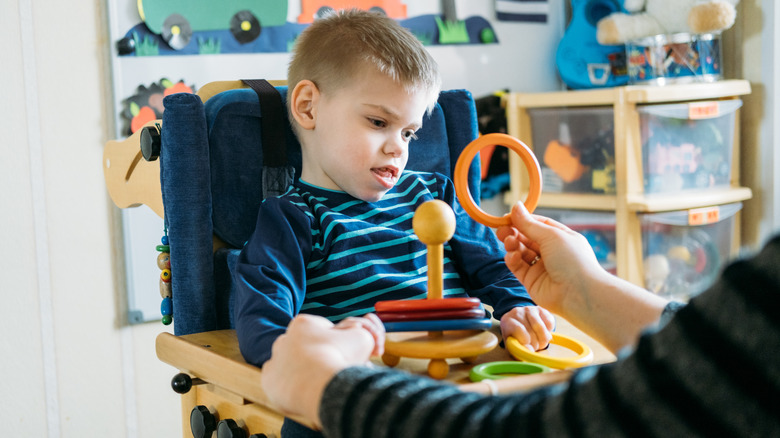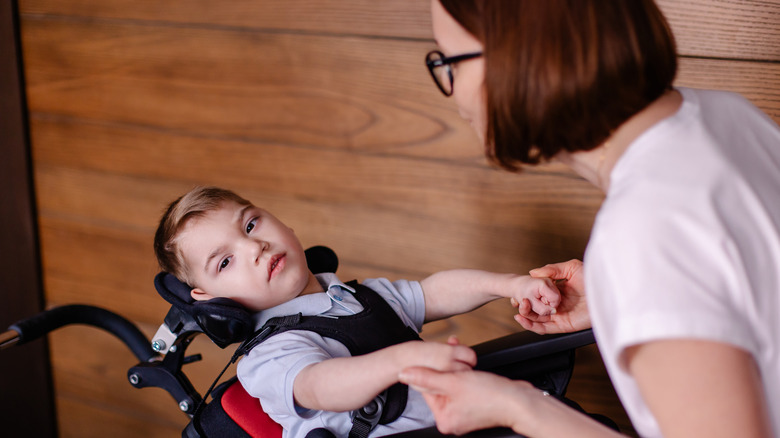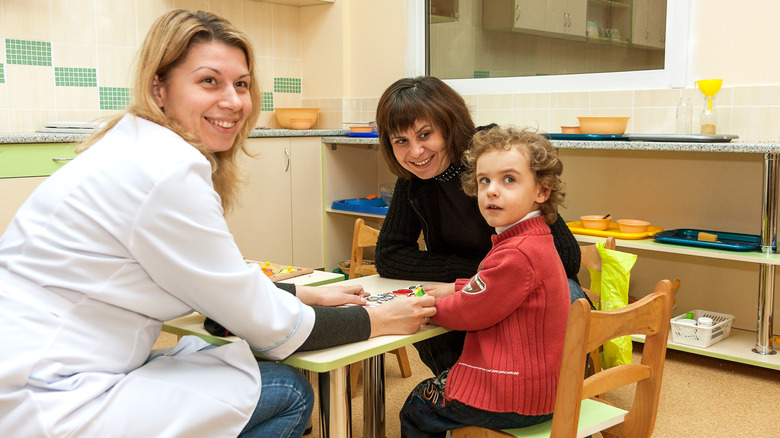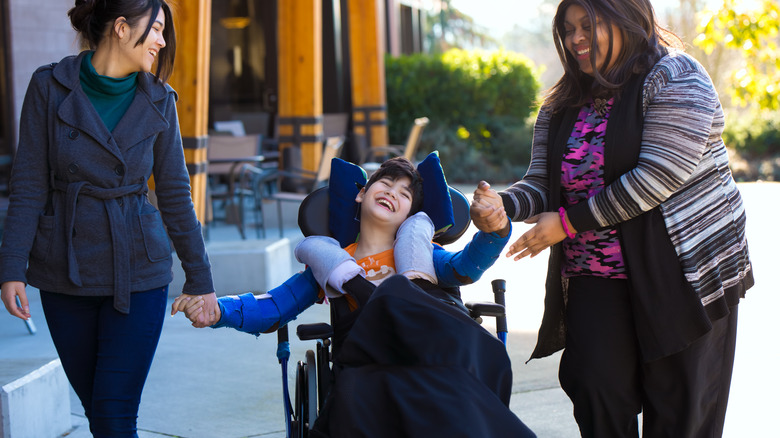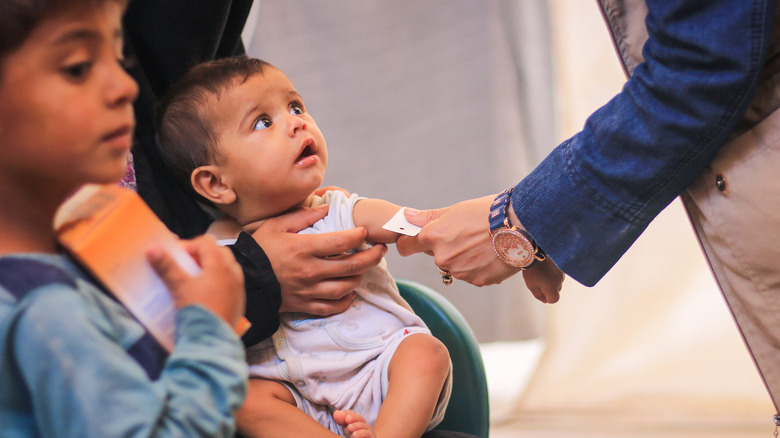Cerebral Palsy Explained: Causes, Symptoms, And Treatments
According to the Centers for Disease Control and Prevention (CDC), cerebral palsy is a motor disorder that impacts someone's ability to control their body's motion, balance, and posture. Depending on the severity of an individual case, this can lead to difficulty with or an inability to do things like walking, talking, writing, or basically any activity involving bodily movement. Many people with cerebral palsy also have a cooccurring condition like epilepsy, a behavior disorder, or issues with sight and hearing. Cerebral palsy affects between one and four people out of every 1,000 born (via the CDC). Though it's typically diagnosed within the first two years of life, it may take longer to diagnose some children whose symptoms are less severe (via the CDC).
There is no cure for cerebral palsy. However, treatment can make a meaningful difference in the life of someone with this condition, so getting a diagnosis as early as possible is vital. Here's what you should know about the symptoms, needs, and treatment options for someone with cerebral palsy.
What causes cerebral palsy?
The Eunice Kennedy Shriver National Institute of Child Health and Human Development notes that for most cerebral palsy cases, the specific cause isn't clear. However, it's known that this health issue is due to unusual brain development or brain injuries. And when it comes to unusual brain development, certain factors like gene alteration, trauma, fever, and infections can make the brain develop in an odd way that clears the way for cerebral palsy. In most cases, cerebral palsy is congenital — which is to say, the person was born with it. However, it can be developed after the newborn stage.
The National Health Service (NHS) says that common infections that a pregnant mother can get that may cause cerebral palsy are chickenpox, cytomegalovirus, toxoplasmosis, and rubella. In an infant, infections like meningitis and encephalitis are also associated with cerebral palsy. Trauma that may lead to cerebral palsy includes poor oxygen flow to the fetus's brain during pregnancy (due to issues like an impaired umbilical cord), head injuries, or brain bleeding due to stroke or other issues (via The Eunice Kennedy Shriver National Institute of Child Health and Human Development). Destruction of the brain's white matter that coordinates signals from the brain to other body parts that regulate body movements can also be a factor — this kind of trauma typically occurs between weeks 26 and 34 of pregnancy, when the developing fetus's brain is particularly vulnerable.
Types of cerebral palsy
Cerebral palsy can be classified into one of four main types — spastic, dyskinetic, ataxic, or mixed — based on the effect it has on the body (via the CDC). In spastic cerebral palsy, the affected person has a higher muscle tone than normal, and this muscle tightness can make movement difficult or less coordinated. Someone with dyskinetic cerebral palsy has trouble regulating the movement of their limbs, and sometimes also struggles with controlling the tongue and face, which can impact things like talking and eating. Ataxic cerebral palsy involves issues with coordinating tasks and general balance. People with this type may struggle to write, stretch their hands to get something that's slightly far away from them, or walk far. Mixed cerebral palsy may combine features of two types of cerebral palsy.
The condition may also be defined by which parts of the body are most impacted. The Cerebral Palsy Alliance notes that it may affect your two arms and legs (quadriplegia), mostly the legs (diplegia), or an arm and leg on the same side of the body (hemiplegia).
Risk factors for cerebral palsy
Several factors increase the likelihood of the occurrence of cerebral palsy, says The Eunice Kennedy Shriver National Institute of Child Health and Human Development. The first factors are premature birth (earlier 37 weeks) and decreased birth weight (below 5.5 pounds). Multiple pregnancies (of two or more babies) carry a greater risk than singletons. During pregnancy, if the mother gets a fever, has different blood factor from the unborn child, or interacts with harmful chemicals like methyl mercury, cerebral palsy is more likely to occur in the baby. Certain underlying health conditions in the mother, such as thyroid issues, might also contribute. Additionally, labor and birth complications that impact the baby's heart and breathing can be a factor. After birth, if the baby develops seizures, jaundice, breathing and heart issues, or sustains a brain injury, cerebral palsy may occur down the road.
All this said, MyChild at CerebralPalsy.org notes that whether these risk factors exist in your (or your baby's) case or not, it doesn't mean for sure that the condition will occur. However, if one or more of these issues was present during a baby's fetal development, birth, or early infancy, it's important to keep in mind that the risk is elevated and to look out for potential symptoms indicating cerebral palsy.
Signs and symptoms to look out for
You may not see clear signs or symptoms of cerebral palsy in your baby immediately after they're born (per the NHS), but within the first 24-36 months the condition will become more obvious. A baby with cerebral palsy might struggle to raise their head during tummy time (per the Cerebral Palsy Alliance), favor one side of the body, have muscles that seem either too weak or unusually stiff, experience muscle spasms, or have trembling hands (via the NHS). When in motion, they might tiptoe rather than walking flatfooted, or make awkward movements which aren't planned for. Those with cerebral palsy may also show other accompanying symptoms such as constipation, sleeping problems, inability to hear, eyesight issues (like unexpected movements of the eyes or poor vision), difficulty learning, epilepsy, trouble speaking or communicating, an unusually bent spine, hip dislocation, acid reflux, bladder control issues, and other eating, swallowing, and drooling problems. Symptoms may cause the baby to miss typical developmental milestones such as sitting up around 8 months of age, walking by 18 months, or beginning to talk by 2 years. If you notice any problems with movement or coordination in your baby, or if they're not hitting expected milestones, be sure to raise your concerns with your child's pediatrician.
Diagnosing cerebral palsy
According to the CDC, medical experts take three main steps when determining whether someone has cerebral palsy. The first is developmental monitoring. Here, observing how a baby develops over the months is critical. As you take your baby for regular checkups, you and your doctor can keep track of their progress. Your doctor will look at your baby's movements as they carry out exams. If the doctor sees concerning signs, they will proceed to the next step: developmental screening. In this step, the parents may fill out a questionnaire to help the doctor understand the baby's health status. Also, the doctor may perform some screening tests to determine whether the baby has issues with movements or motor function. Screening is performed at different periods — 9 months, 18 months, and around 24-30 months.
If your doctor gets worrying results from the tests, you and your baby will proceed to the next step, developmental and medical evaluations. This step is all about narrowing down the actual health issue your baby has by looking at their reflexes, posture, and motor skills. The baby's medical history also helps a great deal here. Additional tests such as magnetic resonance imaging (MRI), metabolic testing, computed tomography tests, genetic testing, and an EEG (electroencephalogram) may be a possibility too. The Mayo Clinic adds that a cranial ultrasound to provide brain imaging is another scan your physician is likely to order when checking for cerebral palsy.
Levels of severity
A crucial aspect that medical experts look at when determining how much a person has been affected by cerebral palsy is their ability to navigate their environment (via the Cerebral Palsy Alliance). How they move from one to point to another helps the doctor to classify the level they are in and come up with an optimized treatment and management program.
There are five cerebral palsy levels. Someone in level I can walk, jump, and run without needing help. They can even go up the stairs without using the railings. However, they may struggle with their coordination skills, speed, and balance. In level II, someone with cerebral palsy can walk, but not for an extended period. Assistance using hand equipment, wheeled devices, or other assistance machines can help them increase the distance they can cover on foot. They can also use the stairs, but they would need railings for support, and can jump and run but not as well as those in level I. Those in level III may need railings and supervision as they use the stairs, and wheeled devices can also help them when they're going far. Those in level IV rely on self-driving wheelchairs or human assistance (for the most part), and in level V, they will require consistent assistance with mobility and maintaining body posture, especially of their heads, arms, and legs. Neofect adds that use of lateral supports and head rests are common for those in level V.
Treatment for cerebral palsy
Though cerebral palsy cannot be cured, there are several treatment options to help reduce the effects of the condition (per the NHS). Some of these include physiotherapy, which seeks to preserve or improve the patient's ability to move by improving muscle and strength and flexibility. Speech and language therapy is another reliable intervention that helps the patient to communicate independently by speaking verbally or with sign language, or with an assistive device that produces speech or allows communication via symbols. Occupational therapy may also help identify and ease the struggles someone has when going about daily activities like using the washroom or dressing and undressing, and provide better solutions for the problems.
Medication may also help to minimize symptoms. For muscle stiffness, baclofen or diazepam could be useful. Melatonin (to deal with sleeping problems), painkillers (to reduce discomfort or pain), anti-seizure medication (to handle epilepsy), drooling medication, and laxatives (to handle constipation) may also be part of a treatment plan. And on a day-to-day basis, various devices such as splints, casts, braces, powered scooters, rolling walkers, and wheelchairs are possible options to aid with movement, balance, and posture (per the Eunice Kennedy Shriver National Institute of Child Health and Human Development).
Surgical options for cerebral palsy
A number of surgical options are available to help treat spastic cerebral palsy and may be recommended in the case that first-line treatments such as physical therapy and medication haven't produced desired results (via the Birth Injury Help Center).
Orthopedic surgery seeks to enhance gross motor skills, fine motor skills, mobility, coordination, and balance. Areas targeted here are tendons, bones, muscles, ligaments, nerves, and joints. Available orthopedic surgery types include muscle lengthening (to do away with tightness in arm muscles, fingers, and hands), tendon lengthening (to improve posture and walking), tendon transfer (to deal with walking issues and pain), tenotomy (to improve fine motor skills, muscle function, and limb control), osteotomy (to improve mobility), and arthrodesis (to ease pain and better walking abilities). Selective dorsal rhizotomy is a surgical procedure that aims at dealing with severe muscle spasticity. In this surgery, a particular spasticity is fixed when the surgeon cuts the nerve fibers responsible for sending chemical messages to the affected body part.
MyChild at CerebralPalsy.org notes that some people may also need surgery to improve their vision, hearing, or gastrointestinal function. Doctors may also choose to surgically insert a pump into the body to distribute medication. Such a pump requires a re-fill of medication on a set schedule.
Cerebral palsy and coexisting conditions
According to a study published in Developmental Medicine & Child Neurology, cerebral palsy often co-occurs with other health conditions — indeed, the researchers found that most every person with cerebral palsy has a comorbid condition. Some of the most common were gastrointestinal diseases, congenital defects, respiratory diseases and infections, scoliosis, and skin conditions. According to the Birth Injury Justice Center, many of those with cerebral palsy also have trouble swallowing, eyesight problems (like being unable to see your entire expected vision field, inadequate depth perception, a wandering eye, unusual eye movements that keep recurring), and hearing problems (like sensorineural hearing loss that arises from the inner ear's nerves, and conductive hearing loss).
Neurological conditions are also frequently comorbid with cerebral palsy, particularly seizures, epilepsy, apraxia (a disorder affecting movement), dysarthria (weakness in the muscles you use for speech), attention deficit hyperactivity disorder, dyslexia, autism spectrum disorder, and intellectual disability.
Common cerebral palsy complications
The Mayo Clinic explains that muscle spasticity and weakness in cerebral palsy, along with coordination issues, may pave the way to a host of other complications. For instance, tightened muscle tissue — known as contracture — may bring about limited bone growth and bone curving, making joint dislocation and malformation more likely. Cerebral palsy may also lead to osteoporosis, malnutrition, and osteoarthritis. Osteoarthritis is a type of arthritis in which the protective cartilage that surrounds the ends of the bones in various parts of your body like your hands, shoulders, and knees disintegrates. As a result, bones will rub against one another, and the friction leads to stiffness and pain (per the Cleveland Clinic).
Lung and heart problems like aspiration pneumonia are also common occurrences, says the Mayo Clinic. Aspiration pneumonia happens when you accidentally inhale something you meant to swallow, and it causes an infection in the lungs (via Medical News Today). In turn, this can lead to chronic inflammation and lung injury (per Cerebral Palsy). The Mayo Clinic also adds that sleeping problems, intestinal complications, pain, and mental health difficulties may occur too.
Preventing cerebral palsy
As WebMD explains, there's no surefire way to prevent cerebral palsy from developing in a fetus or infant, and medical experts don't fully comprehend why it comes about. Nonetheless, there are precautions you can take to reduce the chances of your baby developing the condition. For instance, people who are thinking of becoming pregnant should stay away from drugs, tobacco, and excess alcohol consumption. Also, potential mothers who have hypertension, eating disorders, diabetes, or sexually transmitted infections should seek medical intervention before getting pregnant. Vaccination for measles and rubella prior to pregnancy is also advised. Those who are regularly exposed to environmental threats such as toxins should discuss with their doctor how to best protect themselves and their fetus during pregnancy. Pregnant people can help prevent infection by maintaining good hygiene. A pregnant person may also need to take medication to prevent complications in the event that they and their fetus have different blood types.
After birth, infants should receive standard vaccinations to help protect them against infections that can lead to cerebral palsy. Baby-proofing and child safety measures in the home and car are also important to help protect infants and young children from brain injury.

